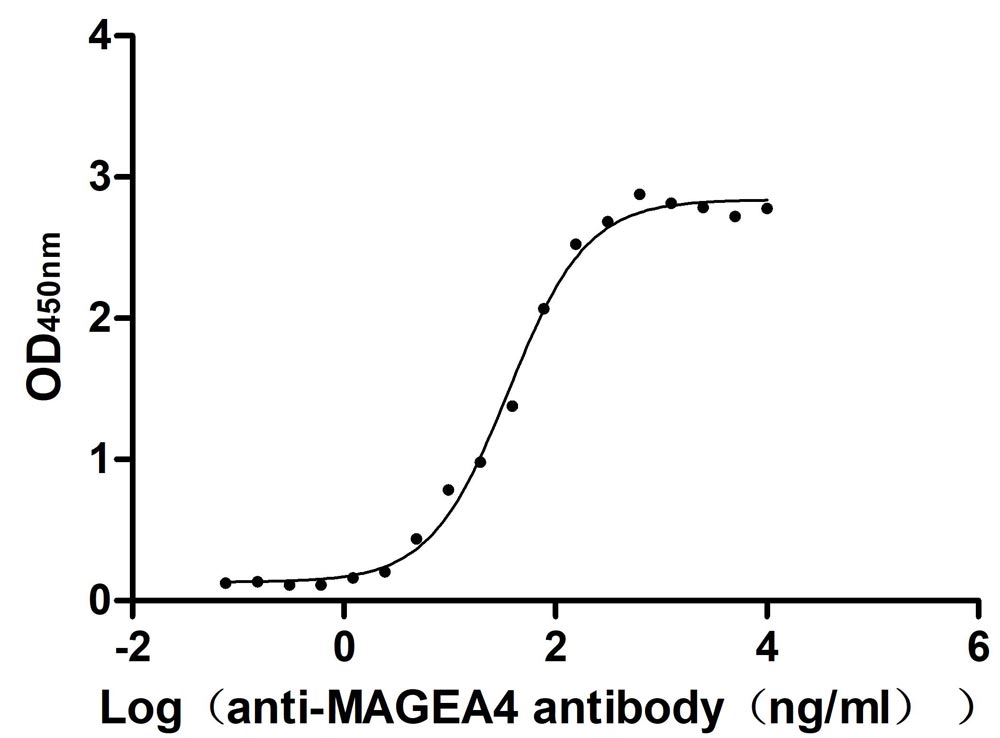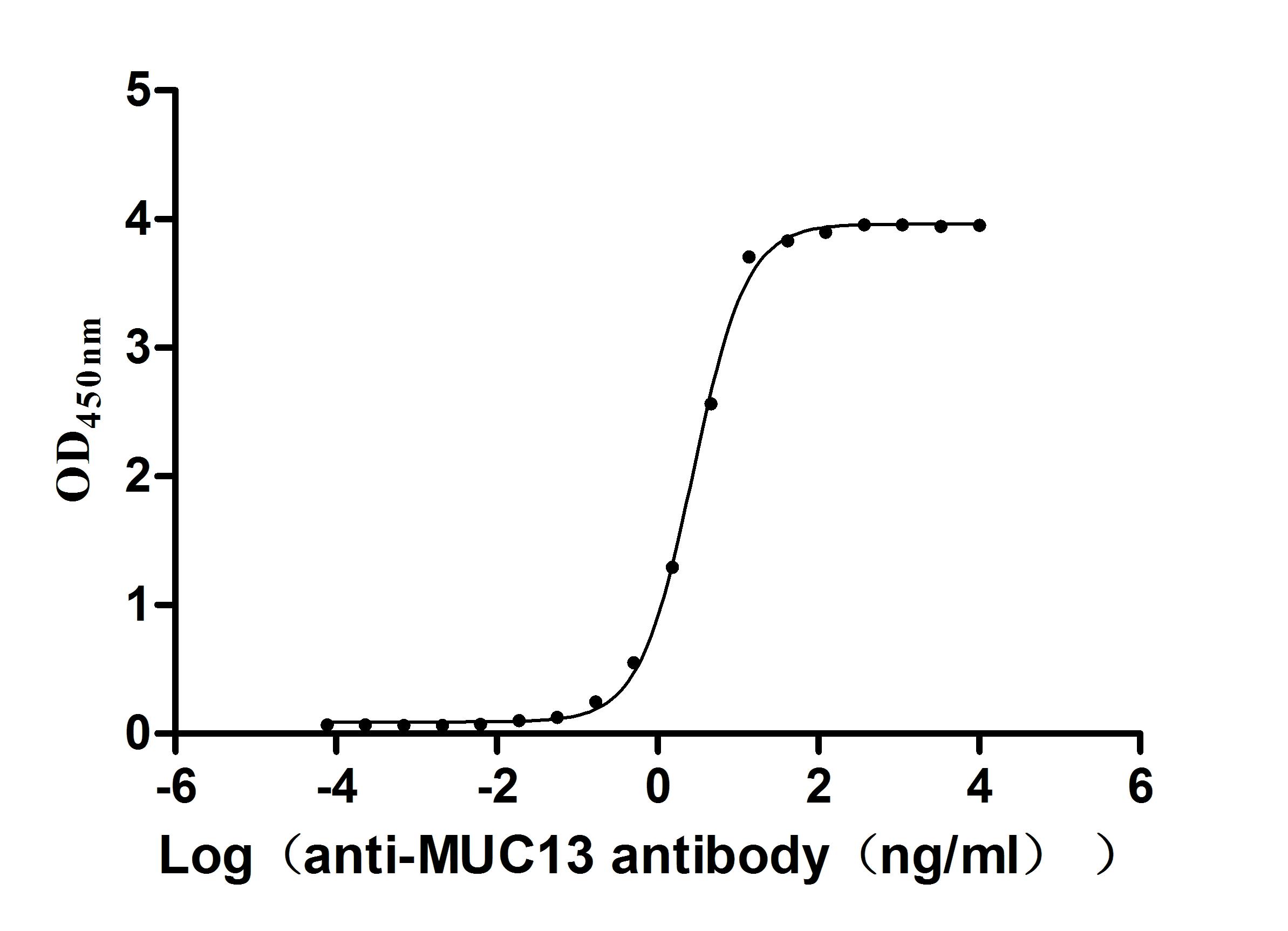Recombinant Human Nucleic acid dioxygenase ALKBH1 (ALKBH1)
-
货号:CSB-YP614439HU
-
规格:
-
来源:Yeast
-
其他:
-
货号:CSB-EP614439HU
-
规格:
-
来源:E.coli
-
其他:
-
货号:CSB-EP614439HU-B
-
规格:
-
来源:E.coli
-
共轭:Avi-tag Biotinylated
E. coli biotin ligase (BirA) is highly specific in covalently attaching biotin to the 15 amino acid AviTag peptide. This recombinant protein was biotinylated in vivo by AviTag-BirA technology, which method is BriA catalyzes amide linkage between the biotin and the specific lysine of the AviTag.
-
其他:
-
货号:CSB-BP614439HU
-
规格:
-
来源:Baculovirus
-
其他:
-
货号:CSB-MP614439HU
-
规格:
-
来源:Mammalian cell
-
其他:
产品详情
-
纯度:>85% (SDS-PAGE)
-
基因名:ALKBH1
-
Uniprot No.:
-
别名:ABH; ABH1; alkB; alkB homolog 1 histone H2A dioxygenase; AlkB; alkylation repair homolog 1 (E. coli); ALKB1_HUMAN; ALKBH; ALKBH1; Alkylated DNA repair protein alkB homolog 1; Alkylation repair homolog 1; Alkylation repair; alkB homolog; Alpha-ketoglutarate-dependent dioxygenase ABH1; DNA lyase ABH1; DNA oxidative demethylase ALKBH1; hABH
-
种属:Homo sapiens (Human)
-
蛋白长度:full length protein
-
表达区域:1-389
-
氨基酸序列MGKMAAAVGS VATLATEPGE DAFRKLFRFY RQSRPGTADL EGVIDFSAAH AARGKGPGAQ KVIKSQLNVS SVSEQNAYRA GLQPVSKWQA YGLKGYPGFI FIPNPFLPGY QWHWVKQCLK LYSQKPNVCN LDKHMSKEET QDLWEQSKEF LRYKEATKRR PRSLLEKLRW VTVGYHYNWD SKKYSADHYT PFPSDLGFLS EQVAAACGFE DFRAEAGILN YYRLDSTLGI HVDRSELDHS KPLLSFSFGQ SAIFLLGGLQ RDEAPTAMFM HSGDIMIMSG FSRLLNHAVP RVLPNPEGEG LPHCLEAPLP AVLPRDSMVE PCSMEDWQVC ASYLKTARVN MTVRQVLATD QNFPLEPIED EKRDISTEGF CHLDDQNSEV KRARINPDS
-
蛋白标签:Tag type will be determined during the manufacturing process.
The tag type will be determined during production process. If you have specified tag type, please tell us and we will develop the specified tag preferentially. -
产品提供形式:Lyophilized powder
Note: We will preferentially ship the format that we have in stock, however, if you have any special requirement for the format, please remark your requirement when placing the order, we will prepare according to your demand. -
复溶:We recommend that this vial be briefly centrifuged prior to opening to bring the contents to the bottom. Please reconstitute protein in deionized sterile water to a concentration of 0.1-1.0 mg/mL.We recommend to add 5-50% of glycerol (final concentration) and aliquot for long-term storage at -20℃/-80℃. Our default final concentration of glycerol is 50%. Customers could use it as reference.
-
储存条件:Store at -20°C/-80°C upon receipt, aliquoting is necessary for mutiple use. Avoid repeated freeze-thaw cycles.
-
保质期:The shelf life is related to many factors, storage state, buffer ingredients, storage temperature and the stability of the protein itself.
Generally, the shelf life of liquid form is 6 months at -20°C/-80°C. The shelf life of lyophilized form is 12 months at -20°C/-80°C. -
货期:Delivery time may differ from different purchasing way or location, please kindly consult your local distributors for specific delivery time.Note: All of our proteins are default shipped with normal blue ice packs, if you request to ship with dry ice, please communicate with us in advance and extra fees will be charged.
-
注意事项:Repeated freezing and thawing is not recommended. Store working aliquots at 4°C for up to one week.
-
Datasheet :Please contact us to get it.
相关产品
靶点详情
-
功能:Dioxygenase that acts as on nucleic acids, such as DNA and tRNA. Requires molecular oxygen, alpha-ketoglutarate and iron. A number of activities have been described for this dioxygenase, but recent results suggest that it mainly acts as on tRNAs and mediates their demethylation or oxidation depending on the context and subcellular compartment. Mainly acts as a tRNA demethylase by removing N(1)-methyladenine from various tRNAs, with a preference for N(1)-methyladenine at position 58 (m1A58) present on a stem loop structure of tRNAs. Acts as a regulator of translation initiation and elongation in response to glucose deprivation: regulates both translation initiation, by mediating demethylation of tRNA(Met), and translation elongation, N(1)-methyladenine-containing tRNAs being preferentially recruited to polysomes to promote translation elongation. In mitochondrion, specifically interacts with mt-tRNA(Met) and mediates oxidation of mt-tRNA(Met) methylated at cytosine(34) to form 5-formylcytosine (f(5)c) at this position. mt-tRNA(Met) containing the f(5)c modification at the wobble position enables recognition of the AUA codon in addition to the AUG codon, expanding codon recognition in mitochondrial translation. Specifically demethylates DNA methylated on the 6th position of adenine (N(6)-methyladenosine) DNA. N(6)-methyladenosine (m6A) DNA is present at some L1 elements in embryonic stem cells and probably promotes their silencing. Demethylates mRNAs containing N(3)-methylcytidine modification. Also able to repair alkylated single-stranded DNA by oxidative demethylation, but with low activity. Also has DNA lyase activity and introduces double-stranded breaks at abasic sites: cleaves both single-stranded DNA and double-stranded DNA at abasic sites, with the greatest activity towards double-stranded DNA with two abasic sites. DNA lyase activity does not require alpha-ketboglutarate and iron and leads to the formation of an irreversible covalent protein-DNA adduct with the 5' DNA product. DNA lyase activity is not required during base excision repair and class switch recombination of the immunoglobulin heavy chain during B lymphocyte activation. May play a role in placental trophoblast lineage differentiation.
-
基因功能参考文献:
- This study characterized ALKBH1 to be a mitochondrial-localized protein with N6-methyldeoxyadenosine demethylation activity. Loss of ALKBH1 also disrupted mitochondrial OXPHOS function. PMID: 30412255
- Localization and subcellular fractionation studies with the endogenous protein in two cell strains confirm that ALKBH1 is primarily in the mitochondria. PMID: 29097205
- Nuclear and mitochondrial ALKBH1 play distinct roles in tRNA modification. PMID: 28472312
- The s identify ALKBH1/ABH1 as the dioxygenase responsible for oxidising m(5)C34 of mt-tRNA(M)(et) to generate an f(5)C34 modification. PMID: 27497299
- The s postulate that the very low 6-methyl adenine oxygenase activity associated with ALKBH1 is unlikely to represent the major function of the enzyme in the cell, while the cellular role of the lyase activity (including its subsequent covalent attachment to DNA) remains uncertain. PMID: 28290676
- The ALKBH1-catalyzed demethylation of the target tRNAs results in attenuated translation initiation and decreased usage of tRNAs in protein synthesis. PMID: 27745969
- AlkB has a wide variety of substrates, including monoalkyl and exocyclic bridged adducts. (Review) PMID: 26152727
- ALKBH1's role in class switch recombination and abasic site cleavage during base excision repair PMID: 23825659
- Primary and secondary lysine residues of ALKBH1 are involved in lyase reactions and form a covalent adduct with the 5'DNA product, demonstrating two plausible chemical mechanisms to account for the covalent attachment. PMID: 23577621
- Homology modeling and different tertiary structure based study were performed on human AlkB homolog hABH1. PMID: 21956739
- show that ABH1 unexpectedly has a second activity, cleaving DNA at abasic (AP) sites such as those arising spontaneously from alkylation-dependent depurination reactions. PMID: 19959401
- AlkB homologues, hABH2 and hABH3, also are oxidative DNA demethylases; AlkB and hABH3, but not hABH2, also repair RNA PMID: 12594517
- hABH1 is a functional mitochondrial AlkB homolog that repairs 3-methylcytosine in single-stranded DNA and RNA. PMID: 18603530
显示更多
收起更多
-
亚细胞定位:Nucleus. Mitochondrion.
-
蛋白家族:AlkB family
-
组织特异性:Ubiquitous.
-
数据库链接:
HGNC: 17911
OMIM: 605345
KEGG: hsa:8846
STRING: 9606.ENSP00000216489
UniGene: Hs.94542
Most popular with customers
-
Recombinant Human Claudin-18.2 (CLDN18.2)-VLPs (Active)
Express system: Mammalian cell
Species: Homo sapiens (Human)
-
Recombinant Rabbit Tissue factor pathway inhibitor (TFPI) (Active)
Express system: Mammalian cell
Species: Oryctolagus cuniculus (Rabbit)
-
Recombinant Human Melanoma-associated antigen 4 (MAGEA4) (Active)
Express system: Mammalian cell
Species: Homo sapiens (Human)
-
Recombinant Human Angiopoietin-2 (ANGPT2) (Active)
Express system: Mammalian cell
Species: Homo sapiens (Human)
-
Recombinant Human Mucin-13(MUC13),partial (Active)
Express system: yeast
Species: Homo sapiens (Human)


-AC1.jpg)


-AC1.jpg)











